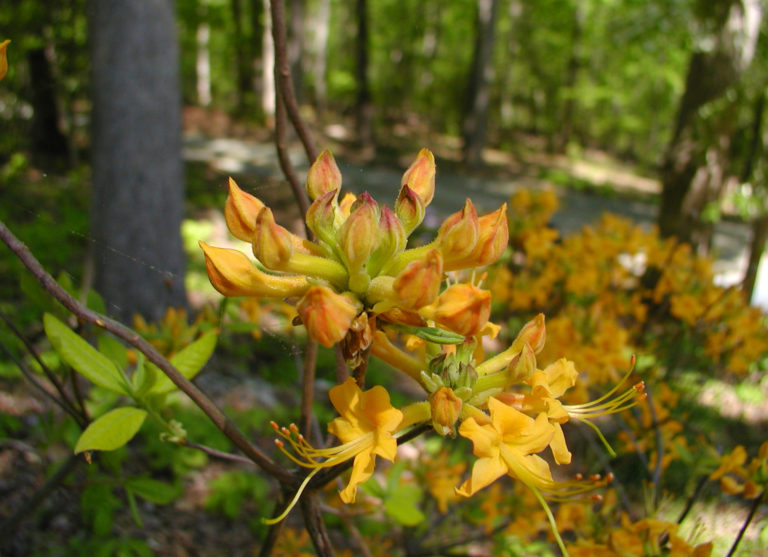The Oconee or Piedmont Azalea is a beautiful deciduous shrub native to woods, slopes, sandhills and edges of stream banks in a few counties in the piedmont of South Carolina and Georgia. It is easy to remember this shrub: Native to a hot area, it is exceptionally heat and drought tolerant for a Rhododendron, and its blooms, which appear in mid-April, take on a range of “hot” colors from reds to oranges to yellows to golds, often several of these at once. Reaching a height of about 8 feet, with an upright habit, R. flammeum is happy in part sun to shade and prefers acidic, organic soils. It is said to resist drought when well established. Piedmont Azalea blooms will bring vibrant color to a shady shrub border, and will attract hummingbirds and butterflies in the bargain.
NURSERY HOURS
Wednesday: 10-4 Thursday: 10-6 Friday-Saturday: 10-4 Sunday: 12-4
Rhododendron flammeum (synonym Rhododendron speciosum)

Key Info
Scientific Name: Rhododendron flammeum (Michx.) Sarg. (synonym Rhododendron speciosum)
Common Names: Piedmont Azalea, Oconee Azalea
Family Names: Ericaceae (Heath Family)
Plant Type: Tree / Shrub
Leaf Retention: Deciduous
Flower Color: Oranges, Reds, Yellows (variable)
Special Characteristics: Attracts bees, Tolerates dry conditions, Attracts butterflies, Tolerates high humidity, Attracts Hummingbirds, Attracts birds, Tolerates heat
Additional Info
Habit: An upright, woody, highly variable azalea shrub. Shallow, fibrous root system.
Height: 6'-8'
Spread: 6'-8'
Soil Conditions: Medium moist, acidic, well drained, organically rich soil, sandy, loamy, clay.
Leaves: Alternate, thin, oval-shaped leaves up to 3½" long turn yellow in the fall.
Flowers (or reproductive structures: Clusters of non-fragrant, funnel-shaped, perfect flowers (1 3⁄4 ”) with 5 petals and 5 dramatic, curved, exserted stamens; bloom in shades of orange, yellow, red (often mixed colors) with a characteristic blotch on the upper floral lobe; blooms in mid-April as the leaves first begin to emerge. Quite varaible.
Fruit: Many seeds in small, brown, elongated capsule.
Natural Distribution: Stream banks, open woods, rocky slopes.
USDA Hardiness Zone: 5 to 9
USDA Wetland Indicator Status in NC: not available
Pollination: Bees, butterflies, hummingbirds.
Wildlife Connections: Important species for native bees and bumble bees.
Propagation: Propagated from seeds or by layering or by softwood cuttings.
